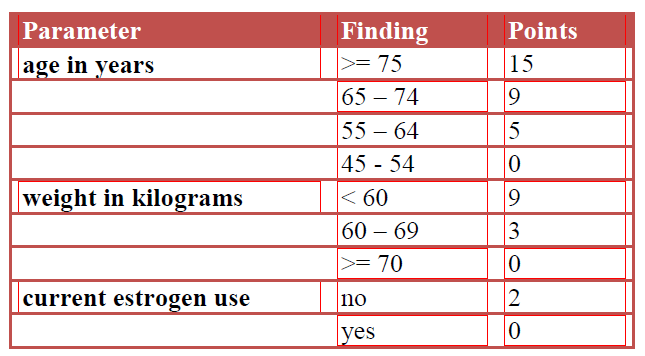The Osteoporosis Risk Assessment Instrument (ORAI): Difference between revisions
No edit summary |
Kim Jackson (talk | contribs) m (Removed rss feed) |
||
| (3 intermediate revisions by 2 users not shown) | |||
| Line 1: | Line 1: | ||
<div class="editorbox"> | <div class="editorbox"> | ||
'''Original Editor '''- | '''Original Editor '''- [[User:Ajay Upadhyay|Ajay Upadhyay]] | ||
'''Top Contributors''' - {{Special:Contributors/{{FULLPAGENAME}}}} | '''Top Contributors''' - {{Special:Contributors/{{FULLPAGENAME}}}} | ||
</div> | </div> | ||
== Objective<br> == | == Objective<br> == | ||
The Osteoporosis Risk Assessment Instrument (ORIA) can be used to select women for bone densitometry. This can help reduce the number of women who are screened so that resources can be used for those at risk. The authors are from several medical institutions in Toronto including the University of Toronto. | The Osteoporosis Risk Assessment Instrument (ORIA) can be used to select women for bone densitometry. This can help reduce the number of women who are screened so that resources can be used for those at risk. The authors are from several medical institutions in Toronto including the University of Toronto. | ||
== Patient selection<br> == | == Patient selection<br> == | ||
Canadian women aged | Canadian women aged >= 45 years of age (osteoporosis has a prevalence < 1% in women < 45 years) | ||
== Exclusion criteria == | == Exclusion criteria == | ||
women with a diagnosis of osteoporosis or taking bone active medications other than estrogen-progesterone (calcitonin, biphosphonates, fluoride). | women with a diagnosis of osteoporosis or taking bone active medications other than estrogen-progesterone (calcitonin, biphosphonates, fluoride). | ||
== Parameters<br> == | == Parameters<br> == | ||
| Line 20: | Line 22: | ||
(1) age in years <br> (2) weight in kilograms <br> (3) current estrogen use <br> | (1) age in years <br> (2) weight in kilograms <br> (3) current estrogen use <br> | ||
[[Image:ORAI.png|left]] | [[Image:ORAI.png|left]] | ||
<br> | |||
<br> | |||
<br> | |||
<br> | |||
<br> | |||
<br> | |||
<br> | |||
<br> | |||
<br> | |||
<br> | |||
<br> | |||
<br> | |||
<br> | |||
<br> | |||
<br> | |||
<br> | |||
ORIA score = (SUM(points for all 3 parameters)<br> | ORIA score = (SUM(points for all 3 parameters)<br> | ||
== Interpretation<br> == | == Interpretation<br> == | ||
• minimum score: 0 <br> | • minimum score: 0 <br> • maximum score: 26 <br> • Bone densitometry should be done if the woman has a total score >= 9. <br> | ||
• maximum score: 26 <br> | |||
• Bone densitometry should be done if the woman has a total score | |||
== Performance<br> == | == Performance<br> == | ||
• The sensitivity was 93.3% and specificity 46.4% for identifying Canadian women with low bone density. The sensitivity was 94.4% for women with osteoporosis. | • The sensitivity was 93.3% and specificity 46.4% for identifying Canadian women with low bone density. The sensitivity was 94.4% for women with osteoporosis. | ||
<br> | |||
== Reference<br> == | == Reference<br> == | ||
| Line 59: | Line 72: | ||
Cadarette SM, Jaglal SB, et al. Development and validation of the Osteoporosis Risk Assessment Instrument to facilitate selection of women for bone densitometry. CMAJ (Canadian Medical Assoc J). 2000; 162: 1289-1294. | Cadarette SM, Jaglal SB, et al. Development and validation of the Osteoporosis Risk Assessment Instrument to facilitate selection of women for bone densitometry. CMAJ (Canadian Medical Assoc J). 2000; 162: 1289-1294. | ||
<br> | |||
< | |||
== References == | == References == | ||
<references />. | <references />. | ||
Latest revision as of 15:19, 20 July 2019
Original Editor - Ajay Upadhyay
Top Contributors - Ajay Upadhyay, WikiSysop and Kim Jackson
Objective
[edit | edit source]
The Osteoporosis Risk Assessment Instrument (ORIA) can be used to select women for bone densitometry. This can help reduce the number of women who are screened so that resources can be used for those at risk. The authors are from several medical institutions in Toronto including the University of Toronto.
Patient selection
[edit | edit source]
Canadian women aged >= 45 years of age (osteoporosis has a prevalence < 1% in women < 45 years)
Exclusion criteria[edit | edit source]
women with a diagnosis of osteoporosis or taking bone active medications other than estrogen-progesterone (calcitonin, biphosphonates, fluoride).
Parameters
[edit | edit source]
(1) age in years
(2) weight in kilograms
(3) current estrogen use
ORIA score = (SUM(points for all 3 parameters)
Interpretation
[edit | edit source]
• minimum score: 0
• maximum score: 26
• Bone densitometry should be done if the woman has a total score >= 9.
Performance
[edit | edit source]
• The sensitivity was 93.3% and specificity 46.4% for identifying Canadian women with low bone density. The sensitivity was 94.4% for women with osteoporosis.
Reference
[edit | edit source]
Cadarette SM, Jaglal SB, et al. Development and validation of the Osteoporosis Risk Assessment Instrument to facilitate selection of women for bone densitometry. CMAJ (Canadian Medical Assoc J). 2000; 162: 1289-1294.
References[edit | edit source]
.







